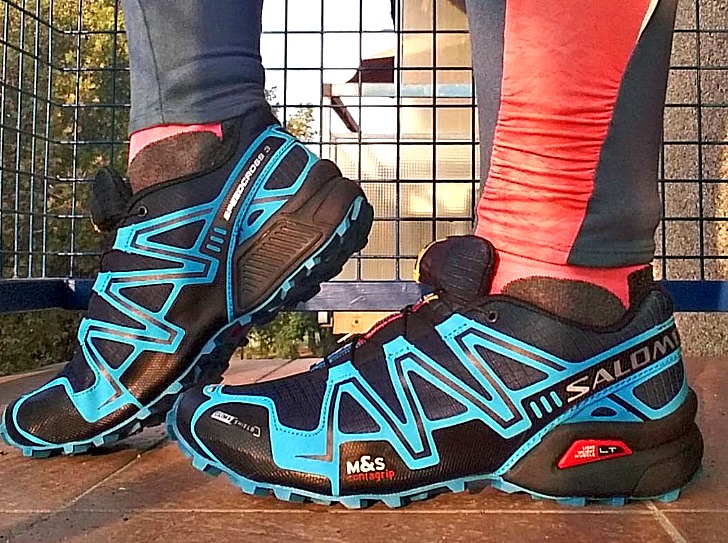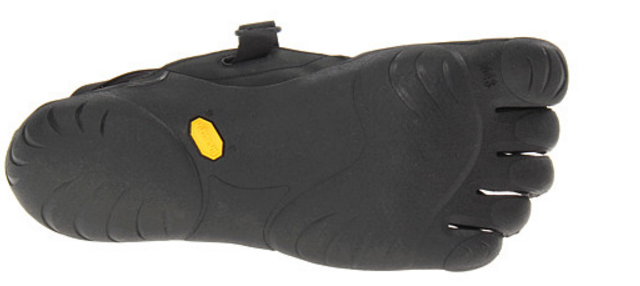Wearing running shoes with traction seems like a good idea for trail running. And, when winter rolls around, many runners are quick to upgrade their footwear to a more treaded shoe. Turns out that too much tread for running is a troublemaker for the knees!
When you learn forefoot running, it is best to learn the technique in a shoe that best looks-like the human foot. If you look at the soles of the bare foot, you will notice that we don’t have tread. Therefore, if you struggle with knee pain while learning forefoot running, your running shoe might have too much tread. Instead, aim for a minimalist shoe with smoother tread pattern.

To all the runners out there, avoid wearing running shoes with protruding/studded traction because a new study found that running in these shoes is linked to tear of the ACL.
Running Shoes with Traction Linked to ACL Injury
New evidence suggests that running shoes with thick traction contributes to cruciate knee ligament injury, such as tearing of the anterior cruciate ligament (ACL) in runners.
A 2010 study in The American Journal of Sport and Medicine found that excessive traction influenced knee ligament tearing and possibly rupture in runners.
The study analyzed 2 types of traction: linear translational traction and rotational traction, both are implicated in ACL ruptures.
The researchers found:
- subjects who ran in running shoes with traction had overall higher ankle joint loading, peak knee joint moments, and peak adduction moments
- high joint moments was due to the increase of the 2 traction types (linear translational and rotational)
- shockingly, running shoes with traction increased knee loading rates into the rupture zone for knee ligaments!
Why Forefoot Runners Don’t Need Shoe Traction
The reality is, we did not evolve tread on our feet to run and shoe traction is certainly a deviation from the natural construct of the human foot.
With that said, shoe traction is an unnatural substrate to the human foot which coincides with the adverse effects it has on ligament integrity of the knee.
Why did we evolve to have ‘traction-less’ feet?
Our barefoot running ancestors adopted a landing strategy that enforced a more stable interaction with the ground.
- a forefoot strike landing pattern provided sufficient traction and balance while running barefoot by a means of reduced center of mass – center of pressure (COM-COP) separation.
- forefoot running is a more ‘compact’ style of running meaing the COM is always near foot strike position, hence the reduction in COM-COP separation. Again, this allows for greater balance control by minimizing propulsion and braking associated with a heel strike landing
- forefoot running involves higher cadence where the feet spend less time on the ground thereby limiting exposure to slippery surfaces
The Take Home Message
To maintain healthy knees as a runner, it would be sensible to run in a shoe that closely resembles the sole of the human foot. Therefore, a smoother sole coupled with a forefoot strike landing will curb knee pain and injury.
If you run with a forefoot strike, you don’t need a shoe with traction for the winter. Why? Because there is less brake force applied to ground (or ice..) when your foot lands toe-to-heel when running.

- The bottom of our feet is smooth, like the sole of the Vibram KSO. It’s rubber outsole is sufficient enough for the trails and for slippery surfaces. Plus, if you run with a forefoot strike, you brake less with the ground, which dramatically reduces your risk of slipping (watch the video below to see what I mean)
Here’s a video I did discussing the matter.
Forefoot Running Tips and Benefits – An article every runner should read. Find out how forefoot running improves performance and reduces the risk of getting injured.
Avoid Heel Strike – Learn how heel strike running causes injury and sabotages performance.
Learn Forefoot Running Faster by Running Barefoot – Today, more and more runners are experimenting with barefoot running as a guidance to run better.
Why Avoid Heel Strike – An overview of the long list of running injuries implicated in running with a heel strike.
Bretta Riches
BSc Neurobiology; MSc Biomechanics candidate, ultra minimalist runner & founder of RunForefoot. I was a heel striker, always injured. I was inspired by the great Tirunesh Dibaba to try forefoot running. Now, I'm injury free. This is why I launched Run Forefoot, to advocate the health & performance benefits of forefoot running and to raise awareness on the dangers of heel striking, because the world needs to know.
Latest posts by Bretta Riches (see all)
- Does Foot Strike Really Matter in Running? YES! - 17/04/2024
- Heel Lifts Increase Injury in Runners - 16/04/2024
- Are Minimalist Shoes Good for Seniors? YES! - 14/04/2024

Hi! nice article! I actually have a torn ACL, which I decided not to operate, and i’m looking into barefoot running. would you recommend it, compared to ‘standard ‘ running?
thanks!